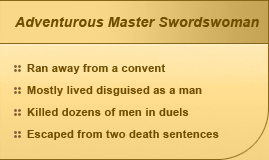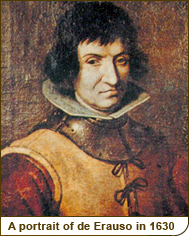

…hustled, killed, maimed, wreaked havoc and roamed about…
—from Catalina de Erauso’s memoirs
There is hardly a town in South America where Catalina de Erauso didn’t have an argument that finished with someone on the end of her sword. Her memoirs, published in 1829 (long after her death), describe an astonishing 20-year period of wandering throughout the continent, from Chile to Panama, so convincingly attired as a man that her immediate family didn’t even recognize her. At a point in history when most women were nuns or obedient wives and mothers, Erauso was fiercely independent.
She was a woman who thought highly of herself, took what she wanted and never looked back. These were atypical qualities for a young woman of her day, as were wielding a weapon, commanding an army and surviving in the wilderness. Erauso, remarkably, did all these things.
The Great Escape
Catalina de Erauso was born in San Sebastian, Spain, in the Basque country. Like many Basque girls, she was sent to school at a nunnery and expected to take vows. However, an argument with a nun who beat her badly provoked the 15-year-old Erauso to escape from the convent on March 18, 1600. She took a small sewing kit, which she used to turn her petticoats into a man’s doublet, and cut her hair, transforming her appearance into that of a young boy.
Pretending to be a boy allowed Erauso to pursue a life a girl could never have. She spent two years working as a page not far from San Sebastian. The day her mother didn’t recognize her in church seemed to be a turning point for Erauso; she left the region permanently and headed to sea as a cabin boy. While the ship on which she was serving was docked at a Panama port, she slipped into the night in search of adventure.
A Lover and a Fighter
At 19, Erauso was living in Saña, Peru, where she’d found work as a shopkeeper. In a theater one Sunday, a man had the audacity to block her view, which resulted in a heated argument between the two. The next day, the man stalked Erauso outside her work, a move that infuriated her. She chased the man down with a saw-toothed dagger and her first rapier, “gave him a slash worth ten stitches” and stabbed his friend for good measure. She then made a run for the church, a safe haven from arrest, but was caught before she was able to reach it. She was thrown in jail, where she stayed for a few months.
The scarred theatergoer, eager to get his revenge, pursued Erauso to the next town after her release. A duel ensued between the two, but Erauso again had the quicker hand. She stabbed the man then once more fled to the nearest church for safety, this time successfully avoiding arrest.
This plot—a duel with a man, a stabbing and an escape to a church—occurs repeatedly in Erauso’s memoirs, usually precipitated by some perceived injustice committed against her or by some misunderstanding involving a lady.
Her memoirs allude to many compromising relationships with young, attractive women, though it is unclear how she managed these liaisons. In fact, her weakness for pretty faces was nearly her undoing on more than one occasion—notably in an unexpected encounter with her brother.
Reporting for Duty
After trying several professions, Erauso joined the military as Alonso Díaz Ramírez de Guzmán; historians assume she was in her 20s at this point. She was posted to Concepción, a Pacific port town in northwestern Chile, where she pleasantly discovered that the governor’s secretary was her own brother, Miguel de Erauso.
Miguel didn’t recognize his younger sister, but he did take a shine to her, appreciating this Basque soldier who reminded him of home. He assigned her to his office, and for three years, disguised as a man, she worked alongside Miguel and enjoyed what she described as “the good life.”
Unfortunately, her fondness for women ended that bliss. Erauso cared for her brother, but she especially liked his mistress. The fistfight this provoked between Erauso and her brother resulted in Erauso’s losing her office job and being sent away to fight the Mapuche Indians in Paicabí, Chile. She found herself in the middle of one of Spain’s bloodiest campaigns against the indigenous population.

The conditions were awful and the battles vicious; Erauso describes herself as “trampling and killing and slaughtering more men than there are numbers.” When she personally recaptured the company flag in one battle, she was promoted to lieutenant, and thus given the other half of what was later to become her immortal moniker, La Monja Alférez, or The Lieutenant Nun.
After various military adventures, including commanding her own company, Erauso was posted back to Concepción, where, she said, “Chance toyed with me, turning my every scrap of luck into disaster.” She found herself picking up old habits: stabbing a man and hiding in a nearby Franciscan church.
After months of hiding in this church, Erauso was able to slip out one night past the governor’s guards when a fellow officer, Lieutenant Juan de Silva, begged her to act as his second in a duel. Ill-advised as it would seem to leave hiding for more dueling, that’s just what she did, on a night she described as so dark “you couldn’t see your hand in front of your face.”
The duel began with the seconds standing by in case of mishap. Erauso heard her friend take a hit and impetuously flouted protocol to jump to his aid. This prompted the other second to enter the fray to maintain a fair fight, and the two seconds carried on fighting in the darkness even after the original pair had fallen, presumed dead. At last, Erauso’s blade found its target, but as the man went down, she thought she recognized the voice that called her a traitor. “Who are you?” she asked, and heard his dying response, “Captain Miguel de Erauso.”
Erauso watched her brother’s funeral the next day from her hiding place in the church. She had traveled across the world and found her brother, only to kill him.
Despite this tragedy, Erauso continued her dueling, brawling, cross-dressing life. However, when an argument over a card game led to her murdering a man in Piscobamba, the ending was different. Thinking no one had seen her stab the man, Erauso didn’t bother with her usual sprint to the church. A sheriff came to get her the next morning, and she was sentenced to death by hanging. Pursued to the gallows by priests cajoling her to make a last confession, she taunted the clumsy executioner: “You, drunk! Put it on right, or don’t put it on at all—I’ve got my hands full with these priests!”
Happily, a fellow Basquero, Martín de Mendiola, managed to arrange a last-minute pardon, and she was released.
A Return to Her Roots
Events in Cuzco around 1620 marked the beginning of the end of her undercover adventure. Another gambling incident led to a nearly fatal duel and another church—this one adjacent to a bishop’s palace. When the bishop, Juan Bautista de Arteaga, demanded her weapons, she replied, “Señor, there are a great many men who would like nothing better than to catch me without them.”
Surprisingly, the bishop moved her to confess her adventures. When a physical exam proved she was not only a woman but also an “intact virgin,” he told her, “I esteem you as one of the more remarkable people in this world.”
The bishop arranged for her placement in a convent, where she stayed for over two years. When word finally arrived from Spain that she had never actually taken vows, she was free to leave, and at 39, she set out for her home country, where news of her exploits preceded her.
Once there, she was honored with two unusual dispensations: King Felipe IV of Spain granted her a generous pension for her military service, and Pope Urban VIII gave her permission to wear men’s clothes, which she continued to do for the rest of her life. She is said to have finished her days in Mexico as a mule-driver and was last seen by a friar who claimed Erauso was wearing “a sword and dagger ornamented in silver.”
:: Roberta Brown
Catalina de Erauso Selected Sources





